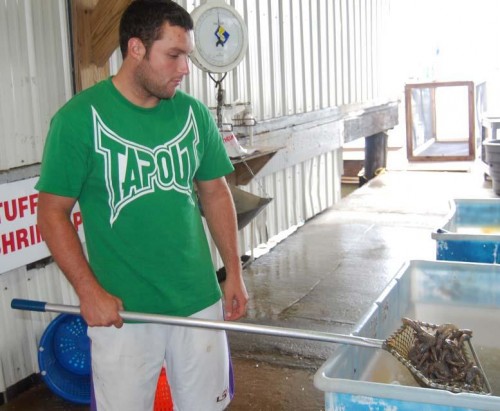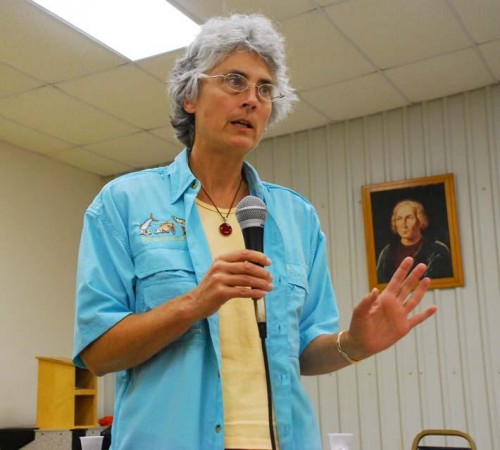
BP spill takes a toll down the bayou
July 8, 2010Wilma Rhodes
July 12, 2010It’s been 21 years since the Exxon Valdez oil spill, and while many of the financial claims still have yet to be laid to rest, many of the clean-up workers who were exposed to toxic chemicals in 1989, have been.
And with more and more Gulf clean-up workers complaining of headaches, sore throats and nausea, Dr. Riki Ott, marine toxicologist and Exxon Valdez survivor, is getting an unwanted wave of déjà vu.
“We got hard hats instead of respirators, just like you,” Dr. Ott recalled. “The material safety data sheet for this oil, it says it’s a respiratory irritant. It’s all concentrated right where the slick hits the surface, so anything that is on that seawater interface is at risk, like dolphins, sea turtles and the workers in their boats trying to respond to this without respirators.”
“Beyond that, it’s a narcotic at high concentrations, and causes headaches, nausea, dizziness, damage to the central nervous system, unconsciousness, coma and death,” Dr. Ott said.
Dr. Ott posted a report on health hazards in the Gulf by sciencecorps.org, which is an informal alliance of people who provide evaluation, communication, technology and other types of assistance in environmental and occupational health, according to its homepage.
The report states, “Crude oil composition varies slightly by its source, but its toxic properties are fairly consistent. Chemicals such as benzene and polycyclic aromatic hydrocarbons (PAHs) are very toxic components of crude oil and of high concern. These and many other chemicals in crude oil are volatile, moving from the oil into the air. Once airborne, they can blow over the ocean for miles, reaching communities far from the spill. They may be noticed as petroleum odors. Consequently, both those working on the spill and people who are far from it can be exposed to crude oil chemicals in air.”
According to recent data collected through air monitoring of the shoreline by the Environmental Protection Agency (EPA), airborne chemicals have not yet reached communities near the Gulf.
“We have a set standard of regulator numbers and once the atmosphere reaches those regulatory numbers, there’s a problem. It may not be harmful to human health, but it’s a problem, then we go into action,” said Sam Tates, an EPA representative.
But it’s organizations like OSHA and BP subcontractors that test the air offshore, and make safety recommendations according to the findings. No respirators have been needed yet, according to BP.
“We are always monitoring environmental conditions, and the industrial hygienists who are doing this air quality monitoring have told us that the level of volatile organic compounds (VOCs) that are present in the samples indicate that respirators are not appropriate and not needed,” said Hugh Depland, a representative of BP.
BP hasn’t made believers out of Dr. Ott or many of the commercial fishermen who work in the spill.
The bottom line: Dr. Ott and commercial fishermen say respirators are vital in ensuring the health and safety of workers They also stress the need for qualified doctors to recognize symptoms from overexposure to chemicals, so symptoms will not be written off as heat stroke, food poisoning, cold or flu.
“There’s a loophole in federal law that requires all illnesses and injuries to be reported to Occupational Safety and Health Administration (OSHA) unless, it’s a cold or a flu,” Dr. Ott said. “So, 6,722 cases of colds and flu during Exxon Valdez.”
General practitioners are not the answer for this situation, according to Ott.
“Occupational and Environmental Medical doctors (OEM) are what you need. These doctors specialize. If you go to the wrong doctor, they have a little checklist that they are trained with in medical school, where you go down this list and if it’s not anything, the very last thing is to tell the patient to go see a shrink – but it’s not in these people’s heads.”
But the demand for air monitors and respirators on clean-up boats seem to have fallen on deaf ears, according to Dr. Ott and representatives from the commercial fishing community. Workers are also continuing to see doctors hired by BP.
After more than two months, fishing boats are still waiting for something to be done.
“We are still trying to get respirators to fishermen that fishermen can use, because right now the Louisiana Bayou Keeper raised funds and sent them out, but the workers were told if they wore those respirators they’d have their jobs terminated,” Dr. Ott said.
Depland explained the people who have been professionally trained to make the call on the respirator or no respirator debate have said that they are not required.
Dr. Ott has a different theory.
“BP does not want the liability of people seen in respirators because that means there might be long-term monitoring of people’s health.”
But according to EPA’s website, the effects from these airborne chemicals are minimal and short-term.
“The levels we are seeing are not expected to be high enough to cause long lasting effects – but people may experience eye or throat irritation, or headaches. The effects should go away when H2S levels diminish, or when a person leaves the area,” the website stated.
For those getting sick, this “quick fix” doesn’t fly.
“We had an incident happen on our boat where one of the young guys had what they called the ‘heat stroke’ and he spent 3 days in the hospital,” said Kim Chauvin, owner and operator of Mariah Jade Shrimp Co., who said BP practitioners told her workers that they had the flu after being exposed to chemicals.
“I’m a mom of three and I can tell they didn’t have the flu, and I don’t need a PhD to tell somebody that, it’s chemical issues,” she said.
Paul Landry, representative from the Office of Public Health came out to the Bayou Interfaith Shared Community Organizing (BISCO) forum on June 30, to address these concerns with the public.
“We’re wanting to be present at these meetings to hear what your concerns are,” he said, and told those present at the meeting that he would relay the concerns to BP and the Department of Health and Hospitals (DHH) – including the need for independent doctors that specalize.
“Go back and say skip the general practitioners, get the OEM’s out, because we need the OEM’s right there on the spot,” Chauvin said. “That would be the logical thing to do.”
“I have noted your observations, we need to have the right people doing the right things at the right times, and we may need to give this medical presence at the sites a lot more attention,” Landry said, who received a round of applause from the audience.
“I am part of you, I’m a represenative as well as an advocate,” he said.
EPA encourages residents to go to epa.gov/bpspill for up-to-date air monitoring data reports and any other information regarding spill response.
JENNA FARMER











